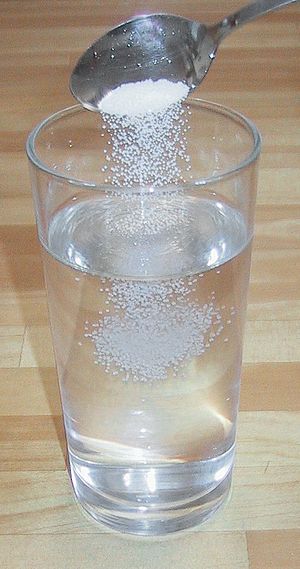Dissolve facts for kids
The word dissolve has a few meanings, but it often describes when a solid substance mixes into a liquid and seems to vanish, creating a solution. Think about stirring salt into water until you can't see the salt anymore. In another way, it can also describe a smooth change in a film or video, like one scene slowly fading into another.
Contents
What Does "Dissolve" Mean?
When something dissolves, it doesn't truly disappear. Instead, its tiny particles spread out evenly through a liquid. This process is very common in everyday life and in science.
Dissolving in Chemistry
In chemistry, dissolving is a special process called solvation. It happens when a solid substance, called the solute, mixes completely into a liquid, called the solvent. The result is a clear mixture known as a solution.
For example, when you add sugar to hot tea, the sugar (solute) dissolves into the tea (solvent), and you get a sweet tea solution. The sugar particles break apart and spread out so much that they become invisible to the eye.
What is a Solution?
A solution is a special kind of mixture where one substance is evenly spread throughout another. It looks like a single substance, even though it's made of two or more parts. Solutions are usually clear, and the dissolved particles are so small that they won't settle to the bottom over time.
Think about air – it's a solution of different gases like nitrogen, oxygen, and argon. Or brass, which is a solid solution of copper and zinc.
How Does Dissolving Work?
When a solid dissolves, the liquid's particles pull the solid's particles away from each other. Imagine tiny magnets: the liquid particles are strong enough to pull the solid particles apart and surround them. Once surrounded, these tiny solid particles float freely within the liquid, making the solution.
If you let the liquid evaporate (turn into a gas), the dissolved solid particles are often left behind. This is how you can get salt back from saltwater.
Factors Affecting Dissolving
Several things can make a substance dissolve faster or better:
- Temperature: Most solids dissolve faster in warmer liquids. Hot water dissolves sugar quicker than cold water.
- Stirring: Stirring helps the solid particles move around and come into contact with fresh liquid particles, speeding up the process.
- Surface Area: Breaking a solid into smaller pieces (like crushing a sugar cube) increases its surface area. More surface area means more places for the liquid to attack and dissolve the solid.
Dissolving in Film and Video
In film and video editing, a "dissolve" is a visual effect used to smoothly transition from one scene or image to another. Instead of a sudden cut, one image slowly fades out while the next image slowly fades in, overlapping for a moment.
This effect is often used to show:
- The passage of time.
- A change in location.
- A dream sequence or flashback.
- A gentle shift in mood.
For example, a scene showing a bright sunny day might slowly dissolve into a dark, stormy night to show that time has passed.


